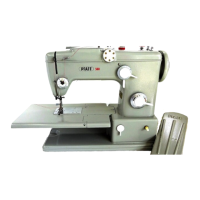To
ensure
that
the
cam
assembly will
rotate
on
ly when the
needle
is out
of
the
material,
the
position
of
the driving eccentric (Figs.
79
and
80)
on
the
arm
shaft
must
be
adjusted
in
proper
relation
to
the needle
bar
crank
(105057). Dur-
ing each revolution
of
the
arm
shaft, the driving lever rna kes
one
sideways
motion
and,
through
a connecting lever
(50371
),
rotates
the
cam
assembly by
a fraction
of
one
revolution (intermittent feed).
The com assembly
naturally must revolve
in
one
direction
only
and,
in
addi-
tion, must
be
retained
in
its position
each
time the
dr
iving lever returns
for
its
next stroke. This requirement has necessitated the incorporation
of
a feed
clutch assembly
made
up
of
a roller clutch
(50473)
and
a clutch
body
(50483)
with a backlash
re
tain~
r.
The
exchangeable
cam
assembly is secured
in
posi-
tion
on
the col
lar
of
the
clutch
body
by a beehive spring
and
a thumb nut
(a
in
Fig
.
51).
Eight feeler fingers,
arranged
spirally
around
a
center
stud
and
offset
at
an
angle
of
45°
aga
inst
one
another,
make
up the feeler finger assembly
(t
in
Fig.
111
).
Cam
selector dial D (Fig.
111)
has
eight
graduat
ions,
one
for
each
feeler finger.
By
turning this
dial
one
eighth
of
a turn
at
a time,
each
feeler
'
finger
is
set
alternate
ly
to
engage
the
cam
opposite.
All
possible
settings
of
the feeler finger
assemb
ly
can
be
covered with
one
complete turn
of
dial
D.
As the
cam
assembly
rotates, the feeler finger rides
on
the
rim
of
the corre-
sponding pattern
cam
and
transmits its rhythmic throws
to
the feeler finger
assembly
carrier
(50386)
,
an
adjustable
connection (50400),
ond
the
engaging
lever driver (50499).
This driver carries three studs
(50498)
each
of
which
is
provided with a slot
to
receive
one
of
the
th
ree
engaging
levers
(50431,
50585,
and
50599). Two
of
these levers
are
hinged
to
a connecting
rod
(105193),
and
one
to
the
zigzag
regulator
arm
(106178).
The front
and
central
engaging
leve
rs
control the stitch width
and
are
secured
in
the
two
holes
of
the connecting rod by
means
of
eccentric studs. Since
each
hole is
arranged
at
a different
distance
from
the
fulcrum
of
the connecting
rod,
the
engaging
lever connected
to
the
lower
of
the
two holes will
cause
the
zigzag
regulator
stud
(106177)
to
make
a
larger
rotation
than
will the
engaging
lever secured
in
the
top
hole.
In
addit
ion, the ·front stud
makes
a
larger
side-
ways motion than
do
the two others.
All
motions
are
adapted
to
one
another
so
that
the
front
engag
ing lever con-
trols the needle motion
for
the
entire
width
of
bightJ while
the
central
engaging
lever controls
the
needle
motion only
for
half the
needle
throw.
The needle position is
controlled by
the
rear
engaging
lever
whose
stroke is
the
shortest
of
them all
and
actuates
the
zigzag
regula
to
r
arm.
27

